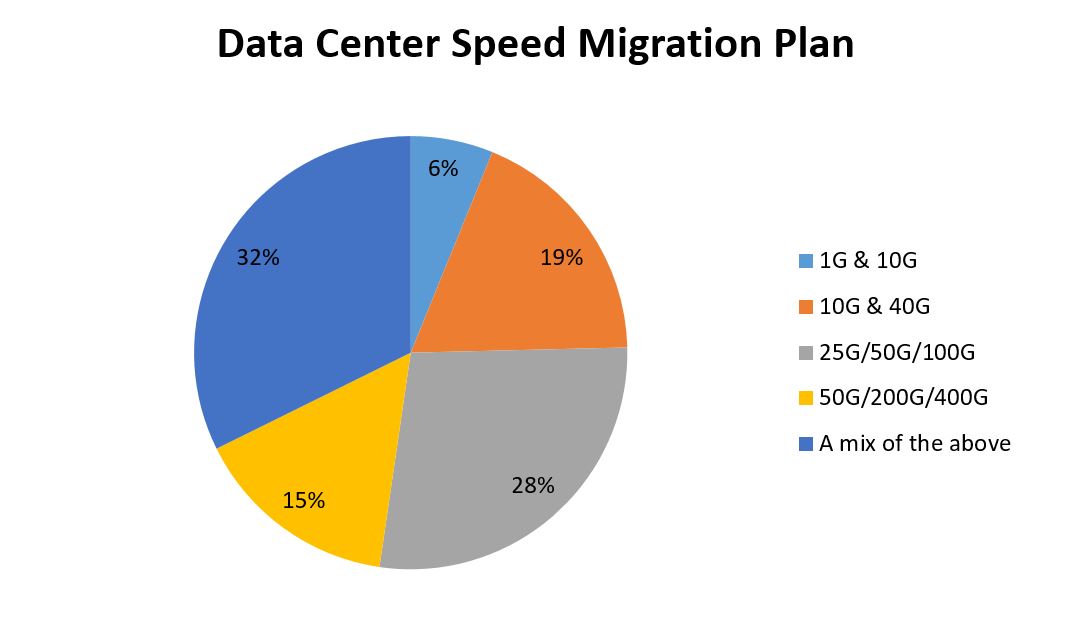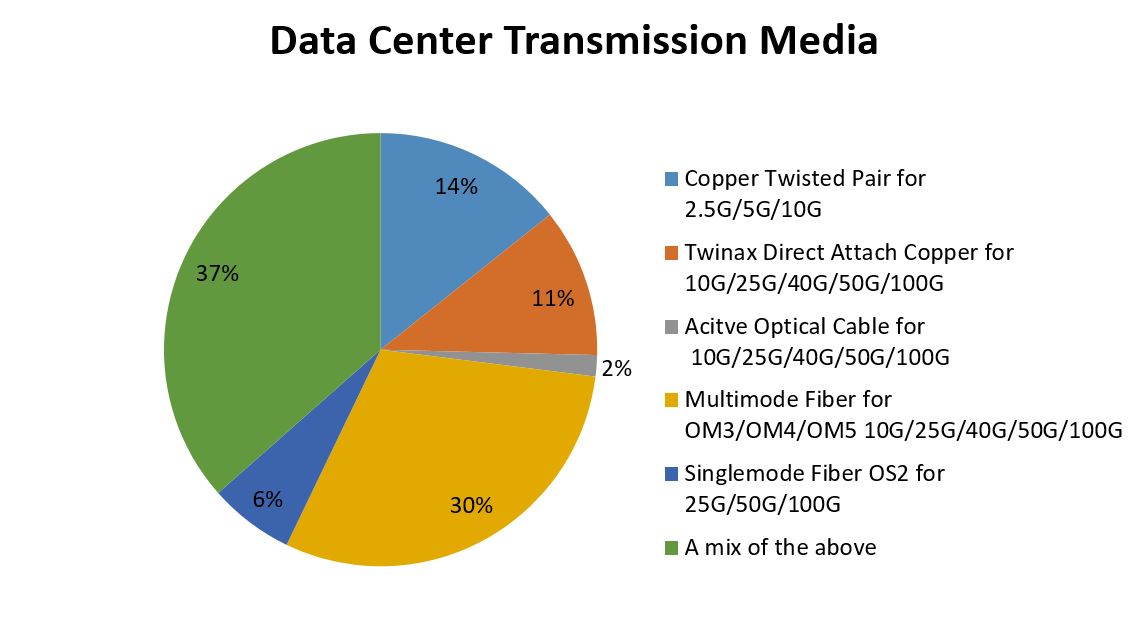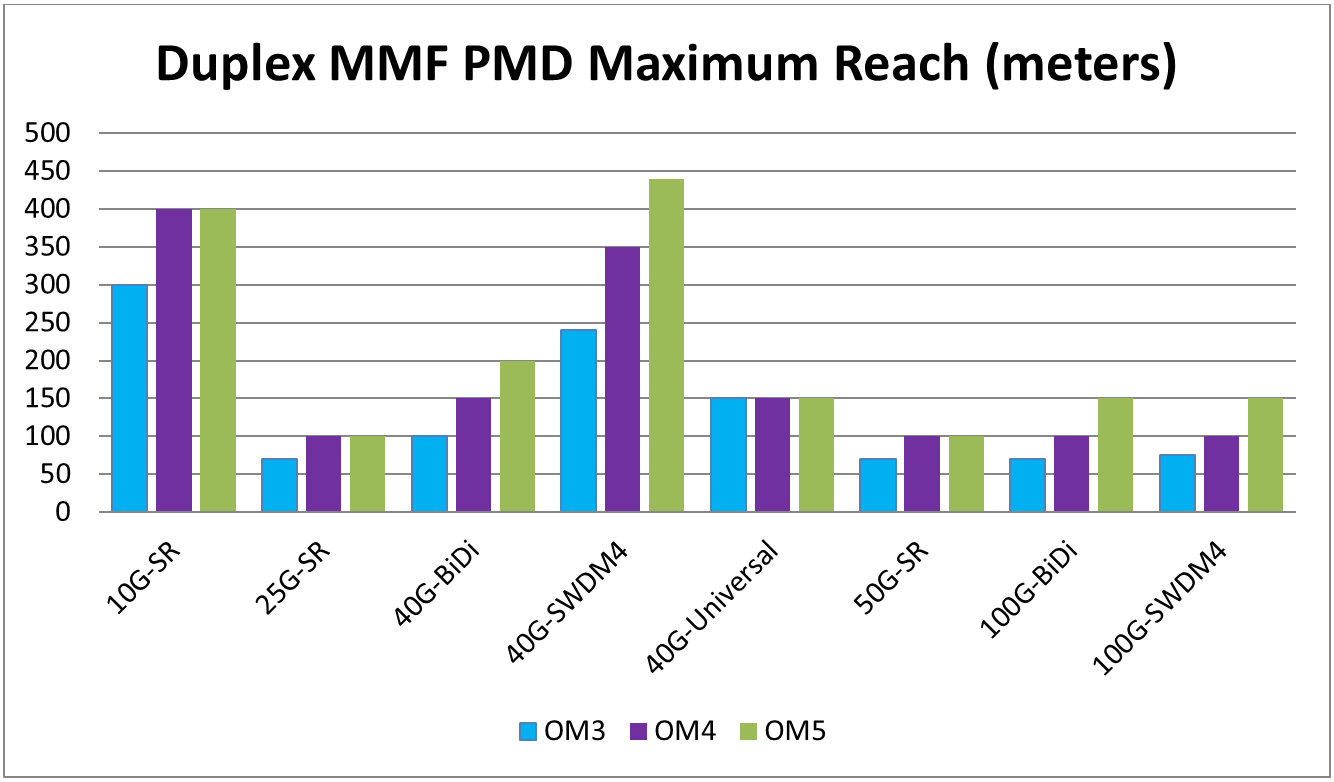Upgrading Networks to 100G and Beyond with Installed-Base Multimode Fiber
Global IP traffic has been increasing rapidly in enterprise and consumer segments, driven by growing numbers of Internet users and connected devices, faster wireless and fixed broadband access, high-quality video streaming and social networking.
Data centers are being built to support the more robust computing, storage and content delivery services these users require.
Since 2016, 25G/50G server ports and 100G switch (ToR, leaf, spine and core) ports have become ubiquitous in most hyperscale data centers, replacing previous 10G servers and 40G switches. This speed migration has boosted overall system throughput by 2.5x with small incremental costs. According to Dell’Oro’s forecast, total 100G switch port shipments will outnumber 40G switch port shipments in 2017-2018.
According to our recent survey with Mission Critical magazine, many enterprise data centers have started planning for access network migration to 25G and aggregate/core network migration to 100G; some organizations have already started to consider 50G/200G/400G down the road.

Data Center Speed Migration Survey (Source: Belden/Mission Critical Magazine, 2017)
When the survey asked, “Which structured cabling type will be deployed in your new data center facility?”, unsurprisingly, multimode fiber cabling was still the most popular data transmission media for structured cabling.

Data Center Transmission Media Survey (Source: Belden/Mission Critical Magazine, 2017)
Brownfield and Greenfield Multimode Fiber Cabling in Data Centers
As data center speeds go up, layer 0 (the physical media for data transmission) becomes increasingly critical to ensure link quality.
Web 2.0 companies such as Google, Amazon, Microsoft and Facebook started migration to 100G in 2015. Many of their new deployments use singlemode fiber to best suit hyperscale data center architecture.
In enterprise data centers, although 40G may meet immediate business needs, many organizations are looking for an economical, futureproof migration path toward 100G (and beyond). Considering the historical dominance of multimode fiber (MMF) in data centers, in addition to multimode transceiver cost advantages, multimode fiber cabling systems will continue to be the most popular cabling and connectivity solution for these reasons:
- 90% of MMF links in data centers are below 100 m in reach; therefore, many installed-base brownfield MMF cabling systems can be reused to support future speed migration without link distance shortage.
- When it comes to new greenfield fiber cable deployment, multimode transceiver vendors have developed products that can support up to 400G Ethernet, especially with promising new technology that supports multiple wavelengths over the same MMF thread (i.e. shortwave-wavelength division multiplexing [SWDM]). When the greenfield deployments of today turn into brownfield deployments in the next upgrade cycle, the installed MMF infrastructure will continue to support bandwidth growth.
Both duplex and parallel MMF cabling are options for network upgrades. In this blog, we’ll discuss duplex MMF cabling. In an upcoming blog, we’ll discuss parallel MMF cabling.
Duplex MMF Cabling
Typically, duplex cabling is the most cost-effective interconnect solution (e.g. server-to-switch and switch-to-switch); only two fiber threads are used in a link (one for each direction). The edge pluggable 10G SFP+ (small form-factor) is the de facto single-lane transceiver used not only in datacom applications, but also in telecom applications, thanks to its versatility and high density.
In data center environments, servers equipped with 25G ports use the SFP28 form factor (same as 10G SFP+ but with 2.5x the speed) with the LC Duplex fiber connector interface. Next-generation 50G SFP56 transceivers will keep using the same form factor and connector interface.
In fiber-rich data center environments, multi-fiber trunk cables with arrayed connectors (e.g. MPO-12 and MPO-24) are usually installed in the main interconnect (horizontal link) area. There are two ways they can be deployed:
- Option No. 1: As multiple LC Duplex patch cords are used to connect to transceiver interfaces, a fiber cassette (LC Duplex to MPO conversion) can be installed at the main distribution area (MDA) where servers are located. Another fiber cassette can be installed at the equipment distribution area (EDA) to redistribute optical links to switch ports with LC Duplex patch cords.
- Option No. 2: Hydra fiber assemblies (breakout fiber cables) are used instead of fiber cassettes to connect to the main interconnect MPO trunk cable via fiber patch panels in MDAs/EDAs.
Duplex MMF Cabling with Wavelength Division Multiplexing
Quad small form-factor pluggable (QSFP) is the dominant form factor for 40G (4x 10G) and 100G (4x 25G) Ethernet transceivers. When it comes to speed upgrades from 10G to 40G or 100G, it’s desirable to reuse the installed duplex fiber pair.
BiDi (bi-directional) technology, and recently developed SWDM technology, can considerably reduce MMF counts by transmitting multiple wavelengths over the same MMF thread, offering multiple technical and financial advantages:
- Simplified fiber cable management and deployment
- Lower fiber counts and cabling infrastructure costs
- Allowed reuse of installed duplex fiber cable for smooth speed upgrades from 10G to 40G, 100G and potentially to 200G and 400G
Transceiver modules such as 40G-BiDi, 100G-BiDi, 40G-SWDM4 and 100G-SWDM4 are already available, allowing the use of LC Duplex cabling instead of MPO-12 to reduce fiber count by a factor of four (Base-8) or 6 (Base-12).

Duplex MMF physical medium dependent maximum reach
Above, duplex multimode PMD (physical medium dependent) transceiver choices from 10G to 100G are shown. In many cases, installed brownfield duplex cabling can satisfy speed-upgrade needs, but here are a few tips to keep in mind before making a final decision:
- Maximum reach will decrease at higher bit rates (with 25G and 50G per wavelength).
- 40G-BiDi uses 20G NRZ modulation format, and 40G-SWDM4 uses 10G NRZ modulation format; therefore, 40G-SWDM4 can support a longer reach than 40G-BiDi since there is less transmission penalty in the MMF.
- Legacy OM3 MMF can only support 70 m reach for 25G, 50G and 100G, based on IEEE 802.3 standards.
- OM4 MMF can support 100 m reach for 25G, 50G and 100G.
- New OM5 MMF has been recently developed to support SWDM applications; it can support a maximum reach of up to 440 m for 40G-SWDM4 and 150 m for 100G-BiDi and 100G-SWDM4.
To meet anticipated needs in the future, many organizations are looking for an economical, futureproof migration path toward 100G (and beyond). As these data center speeds go up, layer 0 (the physical media for data transmission) becomes increasingly critical to ensure link quality.
Make sure you subscribe to our blog updates to learn about parallel MMF cabling for network upgrades, which will be covered soon. Don’t miss it! Learn more about our network upgrade capabilities here.
